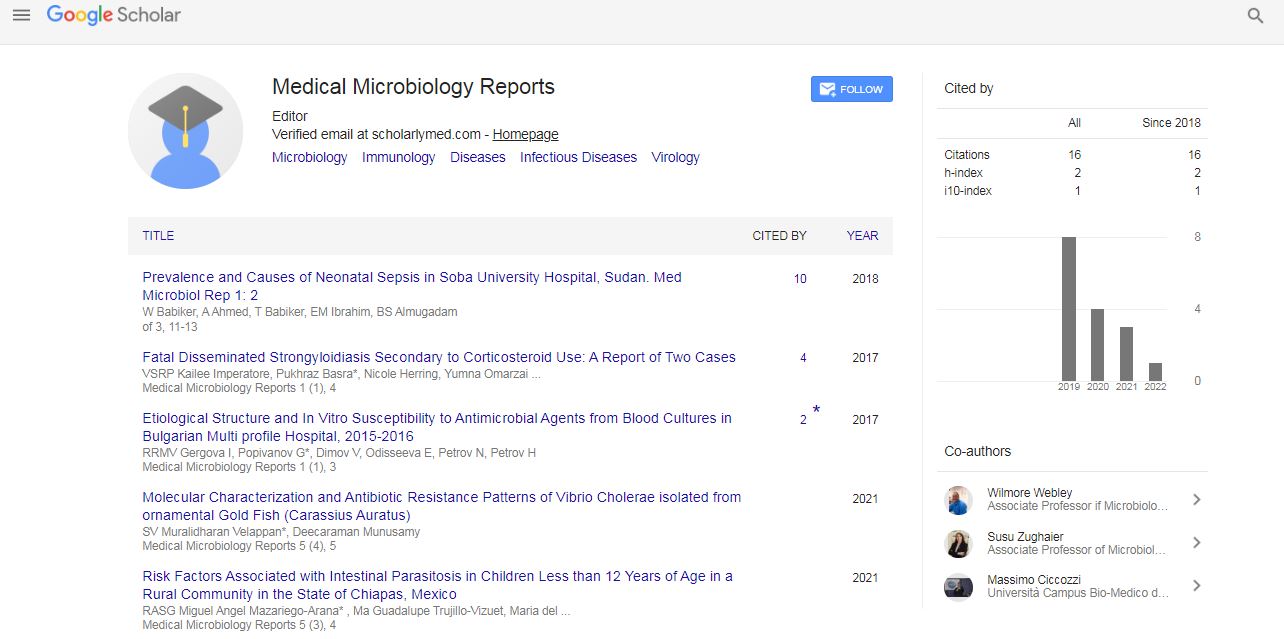Commentary, Med Microbiol Rep Vol: 6 Issue: 2
Emerging In Infectious Diseases Outbreaks Globally
Christopher*
Department of Ecology and Evolutionary Biology, Brown University, 80 Waterman St, USA
*Corresponding Author: Christopher
Department of Ecology and Evolutionary Biology, Brown University, 80 Waterman St, USA
Email: Christopherm@yahoo.com
Received date: 02 March, 2022, Manuscript No. MMR-22-59652;
Editor assigned date: 07 March, 2022; Pre QC No. MMR-22-59652 (PQ);
Reviewed date: 17 March, 2022, QC No. MMR-22-59652;
Revised date: 24 March, 2022, Manuscript No: MMR-22-59652 (R);
Published date: 31 March, 2022, DOI: 10.4172/mmr.1000318.
Citation: Christopher (2022) Emerging In Infectious Diseases Outbreaks Globally. Med Microbiol Rep 6:2.
Keywords: Infectious Diseases
Introduction
Emerging Infectious Diseases (EIDs) are a considerable burden on international economies and public health. Their emergence is notion to be pushed in large part by way of socio-monetary, environmental and ecological elements, however no comparative look at has explicitly analysed these linkages to apprehend global temporal and spatial patterns of EIDs. Right here we analyse a database of 335 EID ‘activities’ (origins of EIDs) between 1940 and 2004, and demonstrate non-random international patterns. EID activities have risen substantially over time after controlling for reporting bias, with their peak occurrence concomitant with the HIV pandemic. EID activities are dominated via zoonoses (60.3% of EIDs): Most of the people of those (71.8%) originate in flora and fauna (as an example, excessive acute respiratory virus, Ebola virus), and are growing drastically over time. we discover that 54.3% of EID events are caused by bacteria or rickettsia, reflecting a huge wide variety of drug-resistant microbes in our database. Our outcomes verify that EID origins are extensively correlated with socio-financial, environmental and ecological elements, and provide a foundation for identifying areas wherein new EIDs are maximum probable to originate (emerging ailment ‘hotspots’). They also reveal a full-size risk of natural world zoonotic and vector-borne EIDs originating at lower latitudes in which reporting effort is low. We conclude that worldwide resources to counter disease emergence are poorly allotted, with most of the people of the medical and surveillance attempt focused on international locations from where the following crucial EID is least in all likelihood to originate.
Severe Acute Respiration Syndrome
Inside the worldwide human population, we record the emergence of 335 infectious illnesses among 1940 and 2004. Right here we outline the first temporal origination of an EID (that is, the unique case or cluster of cases representing an infectious disorder rising in human populations for the primary time-see strategies and as and EID ‘occasion’. Our database includes EID activities because of newly developed strains of pathogens (for example, multi-drug-resistant tuberculosis and chloroquine-resistant malaria), pathogens which have currently entered human populations for the first time (for example, HIV-1, severe acute respiration syndrome (SARS) coronavirus), and pathogens which have likely been present in people historically, however that have recently increased in prevalence (for instance, Lyme disease). The emergence of these pathogens and their next spread has precipitated a really giant impact on worldwide fitness and economies. Previous efforts to apprehend styles of EID emergence have highlighted viral pathogens (mainly RNA viruses) as a primary threat, attributable to their regularly excessive fees of nucleotide substitution, poor mutation errors-correction capability and consequently higher ability to conform to new hosts, together with humans. However, we discover that the majority of pathogens worried in EID events are bacterial or rickettsial (54.3%). This group is usually represented by the emergence of drug-resistant bacterial lines (as an instance, vancomycin-resistant Staphylococcus aureus). Viral or prion pathogens represent best 25.4% of EID events, in contrast to previous analyses which endorse that 37%–44% of emerging pathogens are viruses or prions and 10%–30% bacteria or rickettsia. This follows our classification of every individual drug-resistant microbial stress as a separate pathogen in our database, and reflects extra appropriately the proper importance of antimicrobial drug resistance for international fitness, wherein distinctive pathogen traces can motive separate enormous outbreaks. In broad concurrence with preceding research at the characteristics of rising human pathogens, we find the chances of EID occasions due to different pathogen sorts to be 10.7% for protozoa, 6.3% for fungi and 3.3% for helminthes.
Discussion
A recent evaluation showed a latitudinal spatial gradient in human pathogen species richness growing toward the equator, in common with the distributional sample of species richness located in lots of other taxonomic companies. Environmental parameters that promote pathogen transmission at decrease latitudes (as an example, higher temperatures and precipitation) are hypothesized to pressure this pattern. Our analyses propose that there's no such pattern in EID events, which are focused in better latitudes. The highest awareness of EID occasions in step with million square kilometers of land turned into found among 30 and 60 levels north and among 30 and 40 south, with the primary hotspots in the northeastern U.S.A., western Europe, Japan and south eastern Australia. We hypothesize that socioeconomic drivers (along with human populace density, antibiotic drug use and agricultural practices) are essential determinants of the spatial distribution of EID activities, further to the ecological or environmental situations which could have an effect on overall (rising and non-rising) human pathogen distribution, and that the significance of those drivers relies upon at the class of EID occasion. In particular, we hypothesize that EID events as a result of zoonotic pathogens from flora and fauna are appreciably correlated with flora and fauna biodiversity, and people because of drug-resistant pathogens are extra correlated with socio-economic conditions than the ones because of zoonotic pathogens.
 Spanish
Spanish  Chinese
Chinese  Russian
Russian  German
German  French
French  Japanese
Japanese  Portuguese
Portuguese  Hindi
Hindi 
